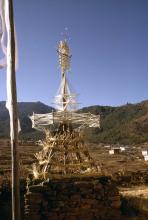
According to Buddhism, we have lived countless past lifetimes and, if we do not reach enlightenment, we will live endless lifetimes in the future. In this process, we accumulate a lot of karmic debt; meaning, we commit actions which lead to rewards and retributions. So, there are many human and non-human beings with whom we have karmic debts to settle, especially as some of those sentient beings will harm us or cause misfortunes as the result of our negative actions towards them in past lives. In order to avert any misfortunes caused by such malevolent spirits, people seek to appease these spirits by conducting different rituals and techniques of pacification.
Moreover, there are many non-human forces with whom we share this existence, and it is important to maintain a good relationship with these forces for harmony in the world. To make up for the intrusive acts and harms we committed against them—knowingly or unknowingly—and instead please them and win their favour and protection, Bhutanese Buddhism recommends carrying out offering rituals to the non-human denizens of the world.
The Bhutanese ritual of offering lü (གླུད་) is a way of appeasing harmful spirits and making offerings to non-human spirits. Such an offering is normally made in the form of an effigy that serves as the scapegoat. Although the theory of karmic retribution comes from Buddhism, the lü ritual is a custom Buddhists adopted from pre-Buddhist religious systems endemic to Bhutan and the Himalayas. In the lü ritual, the spirit is paid a ransom or substitute gift so that the person is spared of any harm. The substitute gift or scapegoat is normally an effigy of a person and/or an animal made out of dough. Samples of food, cloth and all kinds of symbolic riches are included in the offering with the effigy.
Dö (མདོས་) ceremonies are a type of lü ritual when the offering is enshrined in a structure made of intricate thread creations. The Sipa Chidö (སྲིད་པ་སྤྱི་མདོས་), or the dö of all existence, is the most elaborate dö ritual. In the Sipa Chidhoe ritual, priests create a small representation of the whole universe. The structure is built with a central pillar, beams and poles, and wrapped and decorated with colourful threads in intricate designs. The dhoe represents a cosmic mountain, Mt. Meru, and four continents. Depending on the ritual, in some cases, it can also represent a microcosm, or simply a mansion or a house.
The structure is then filled with various offerings, such as the nine kinds of cereals, fruits, clothes, jewelleries, precious metals, etc. It also includes replicas of men, women and children, nine birds that fly in the sky, nine wild animals that roam in the forests, nine amphibians that live on the earth, and nine carnivorous beasts. The human effigies are made of dough and those of the animals and birds are usually made from dough pressed into wooden block molds. Having created this grand structure, which represents the world (or a dwelling), the priests conduct religious rituals and use their meditative powers and mantras to visualize the constructed offerings as real things. With the full conviction that they are real riches, offerings are made to the various non-human spirits, such as the eight classes of gods and devils known as lhasin dégé (ལྷ་སྲིན་སྡེ་བརྒྱད་). Specific offerings are made to the malevolent spirits and to those whom we owe karmic debts as forms of repayment. With these as parting gifts, the spirits are sent off to distant lands. According to some ancient accounts, at times real people are said to have been used as scapegoats, though with the implementation of Buddhism this practice is said to have stopped, and the people replaced with dough models.
The ritual is essentially a method of placating non-human spirits as well as malevolent spirits through a wide range of offerings. It is important that the person(s) for whom the ritual is conducted give generously and believe that the spirits are satisfied so that his or her karmic debts are fully paid off. As these acts are considered good practices of giving and generosity, it is believed to be ideal to insert as many real goods and riches as possible. Short of many real things, the priest basically uses the power of his mind to transform the effigies and token substances into items of great wealth in the eyes of the spirits. Thus, it is important for the priests to carry out the visualisation and meditation effectively.
Lü and dö rituals are expedient ways of practising giving and a skilful way of appeasing and pacifying non-human spirits. Traditionally, they are believed to positively establish order and balance in the world by pacifying non-human forces and redistributing wealth accumulated by the people. Through this practice, one also repays one’s karmic debts. Thus, such rituals are well known for averting sickness, misfortunes, warfare, natural calamities and harm by evil spirits.
Karma Phuntsho is the Director of Shejun Agency for Bhutan’s Cultural Documentation and Research, the President of the Loden Foundation and the author of The History of Bhutan. The piece was initially published in Bhutan’s national newspaper Kuensel as part of a series called “Why We Do What We Do.”
